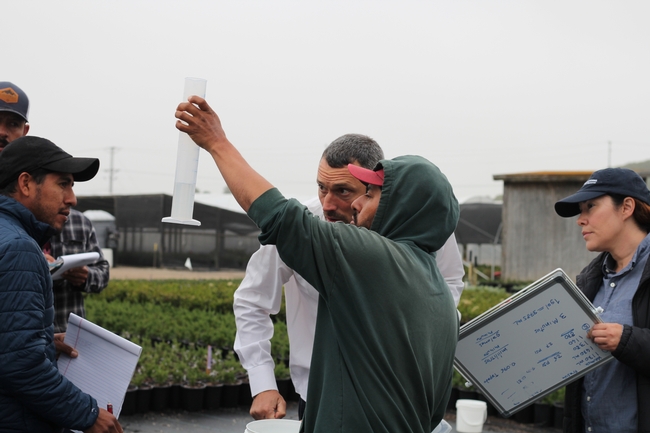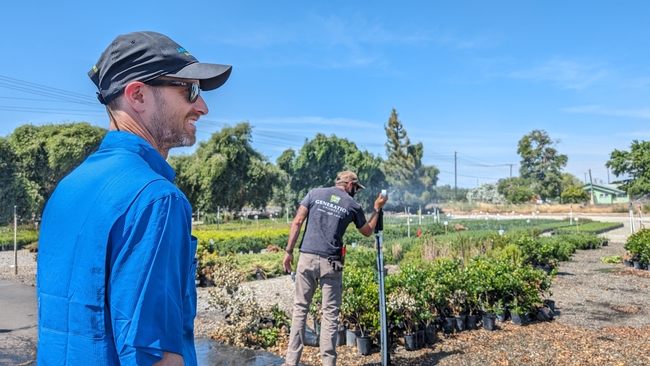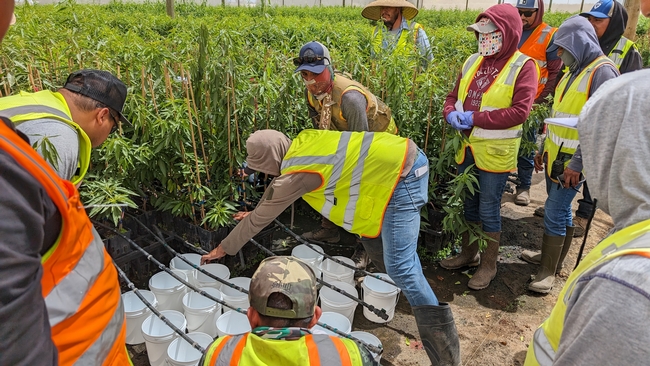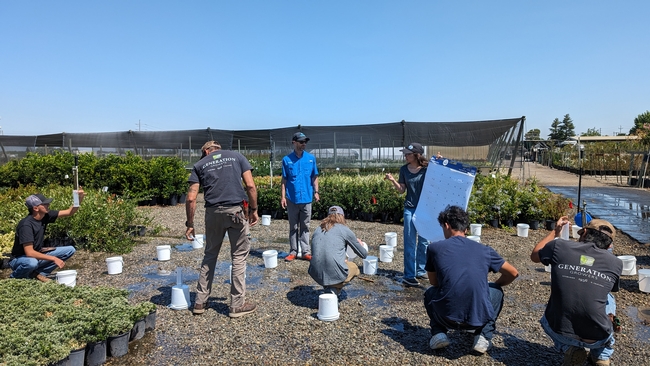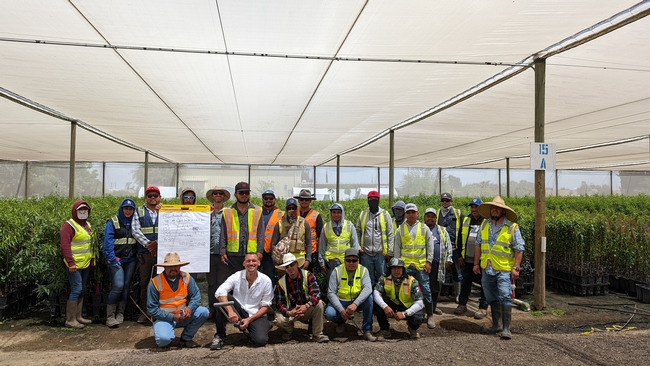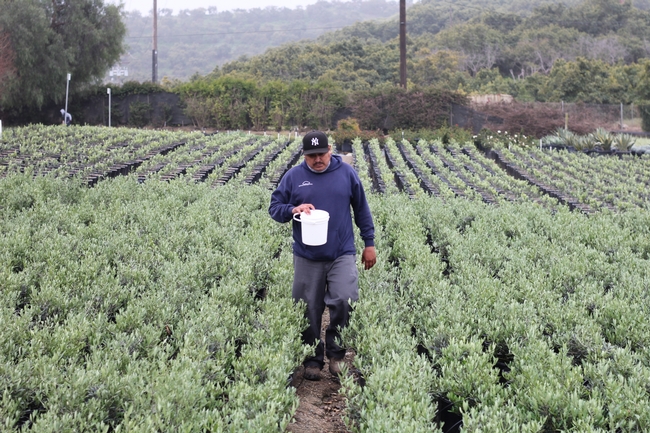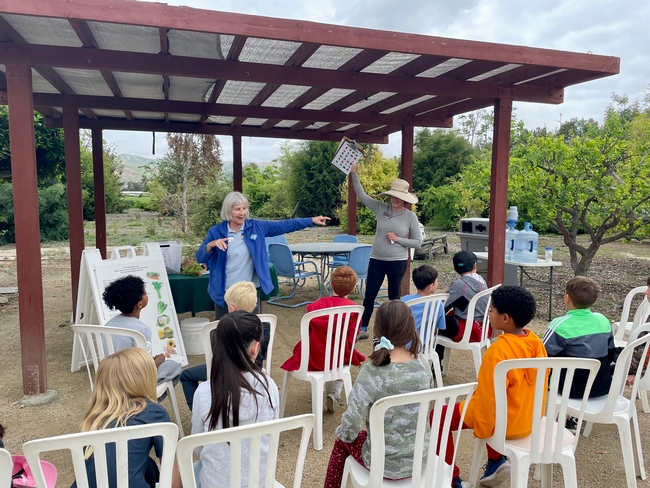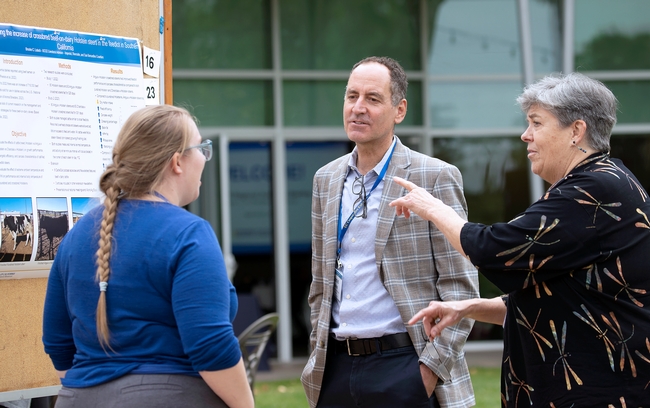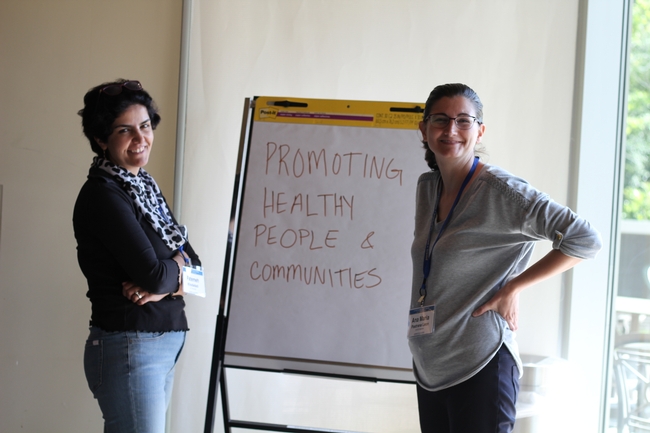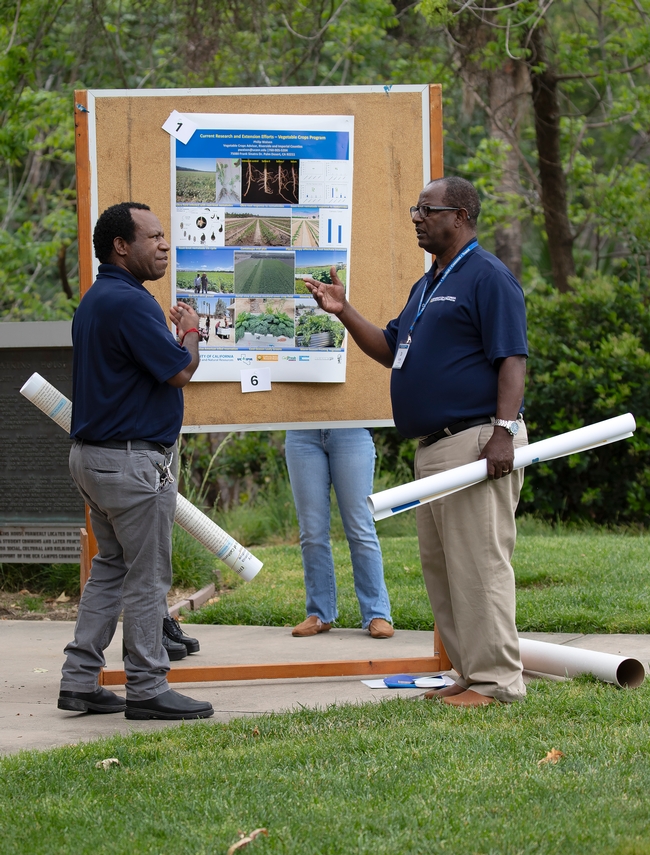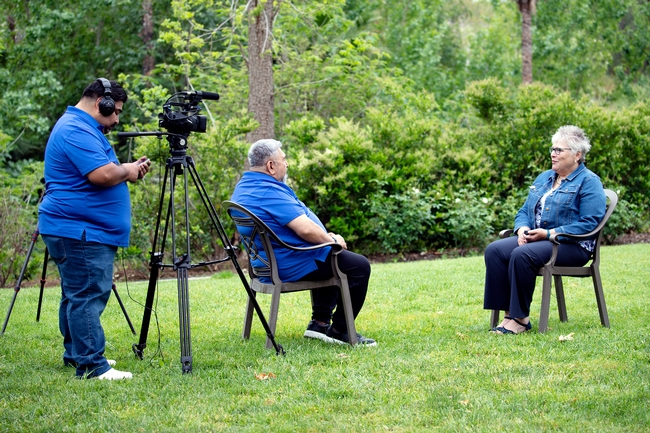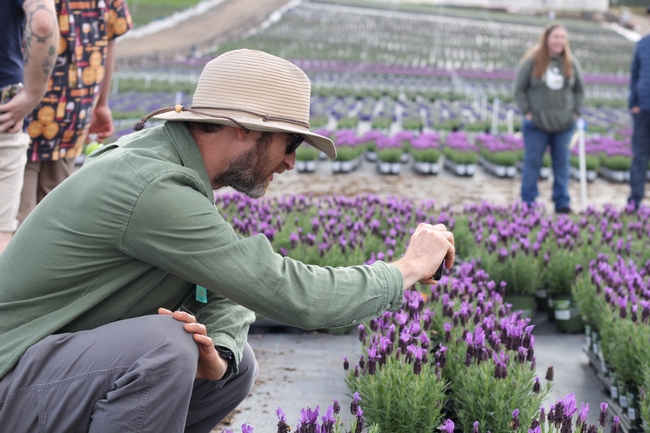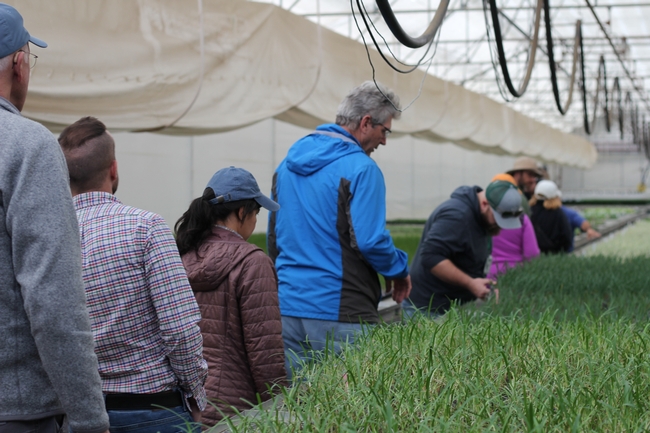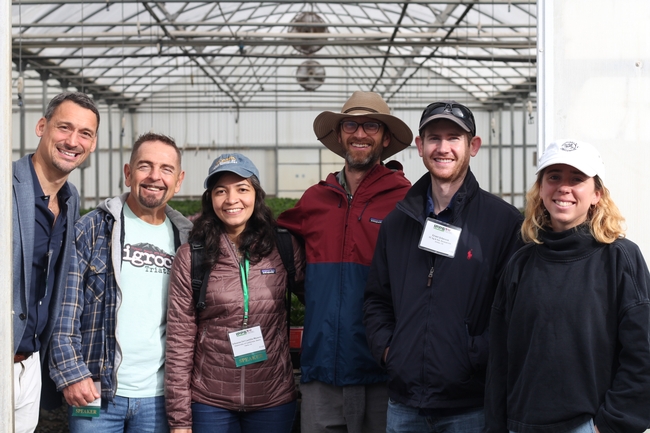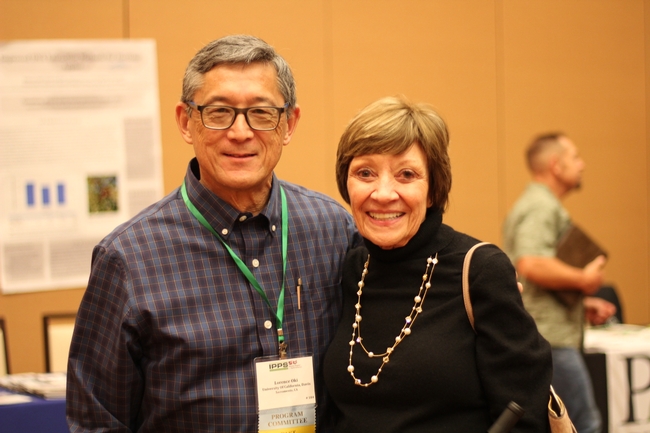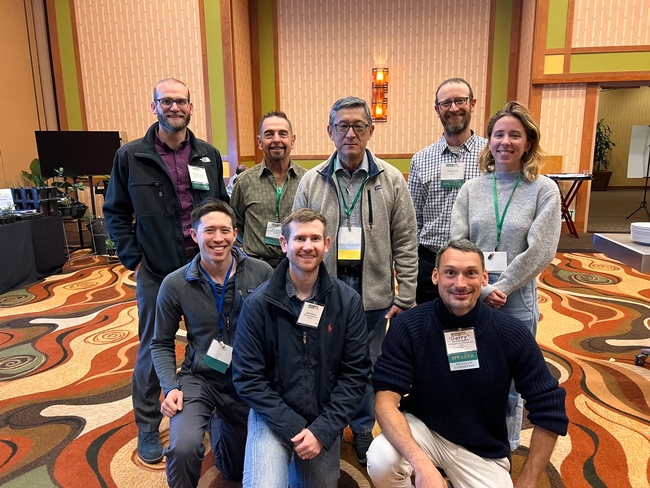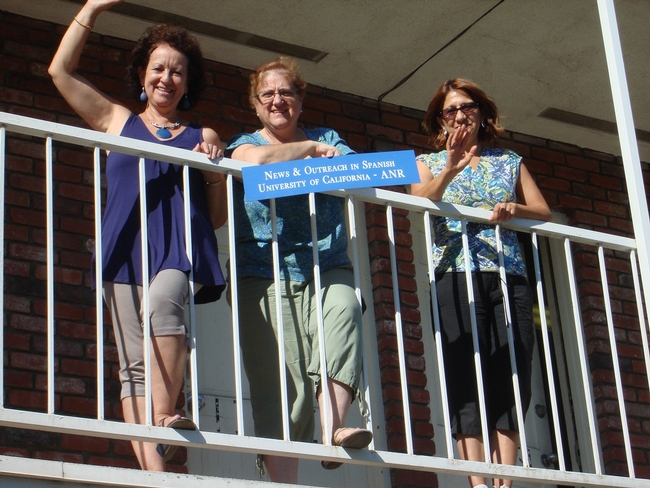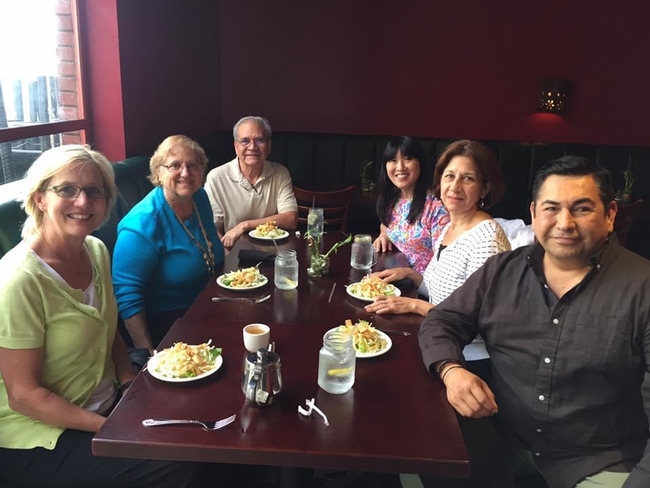- (Public Value) UCANR: Developing a qualified workforce for California
- Author: Saoimanu Sope
UCCE advisors provide free training to nursery and greenhouse staff
Working as an irrigator seems straightforward at first: if you're not watering plants by hand, you're building and managing systems that can do the watering. What could be complex about a job like this?
University of California Cooperative Extension advisors Bruno Pitton and Gerardo “Gerry” Spinelli can tell you – or better yet, show you.
Pitton and Spinelli, members of the UC Nursery and Floriculture Alliance, offer a one-day technical training in irrigation best-management practices for irrigators working with containerized nursery plants. The comprehensive curriculum – developed with input from two focus groups of California nursery and greenhouse managers – aims to improve irrigation efficiency, reduce water consumption and improve plant health.
Thanks to funding from the California Department of Food and Agriculture, nursery and greenhouse managers in California can request this training for free and advisors like Pitton and Spinelli will travel to conduct the training on-site.
The complexities of irrigation incorporate concepts like evapotranspiration, salinity, irrigation uniformity, capillarity, pressure and flow rate. Spinelli, UCCE production horticulture advisor for San Diego County, said that irrigators have a critical role in the industry because of all the things they must consider to do their job well.
“Our goal is to support irrigators and help them become more confident decision-makers and experts in the field,” said Pitton, UCCE environmental horticulture advisor for Placer and Nevada counties.
Interactive sessions reveal nuances of irrigation
The training consists of a presentation on fundamental concepts for managing irrigation in container plant production and hands-on demonstrations. “In the nursery industry, where precise irrigation is crucial for the health and productivity of our crops, having access to expert knowledge is invaluable,” said Mauricio de Almeida, general manager of Burchell Nursery in Fresno County. “The training's practical demonstrations and real-world examples made the concepts easy to grasp, allowing our team to implement the strategies immediately.”
For one of the demonstrations, the advisors used sponges to model soil saturation when water is applied. Ana, an irrigator at Burchell Nursery, appreciated the step-by-step explanations, which helped her better understand how water pressure differs in drip irrigation, sprinklers and watering by hand. Doing this out in the field, as an example of how irrigation audits occur, was extremely helpful for attendees.
Francisco “Frank” Anguiano, production manager of Boething Treeland Farms in Ventura County, observed his team of irrigators as they learned how to measure distribution uniformity with water collected from sprinklers. “This training isn't just about irrigation and plant management. It's also about savings, both water and costs. Who doesn't want to save money and use less water?” Anguiano said.
Reducing the barriers to learning
Many of the irrigators attending these trainings gained their skills and knowledge from life experience rather than a college education, explained Peter van Horenbeeck, vice president of Boething Treeland Farms. “It's important that my irrigators learn from external experts, but it's more important that they can relate to them. And that's what Gerry was able to do,” van Horenbeeck added.
Regarding content and delivery, and referencing what he learned from the focus groups, Pitton wanted the trainings to be easy to understand and engaging. For example, scientists use the term “matric potential” to describe how soil particles hold water against gravity, which is the same as capillary rise. “We demonstrate this concept with a paper towel held vertically and dipped into a beaker of dyed water that it absorbs,” said Pitton.
Many of the irrigators in attendance agreed that hands-on activities and visual aids were instrumental to their learning. Charli, another irrigator at Burchell Nursery, shared that the in-field examples and hosting the training in Spanish kept them engaged.To address language barriers, Spinelli has been conducting trainings in Spanish – a common request from many nurseries with eager participants.
Maintaining state regulations and partnerships
Although the technical aspects of irrigation management are key elements of the training, regulatory compliance is also addressed. Recognizing the finite availability of water and the environmental impact of pollution, the advisors highlight irrigation and fertilizer management and runoff prevention as critical components of compliance.
Under Ag Order 4.0 administered by California's Water Resources Control Board, growers must comply with stricter policies regulating nitrogen use. As irrigators learn from the training, better control of irrigation can certainly make a difference.
Deanna van Klaveren, chief operating officer and co-owner of Generation Growers in Stanislaus County, said the most valuable aspect of the training was learning on-site and completing an audit on her own systems. “It is so much more impactful to have trainings like this on-site where our staff can learn and then go out into the nursery and actually put it into practice while the presenters/experts are there,” van Klaveren said.
Pitton and Spinelli described the partnership between UC Cooperative Extension and CDFA as “symbiotic” given the technical and educational capacity of UCCE advisors who conduct research and extension.
“It's a great example of how the two institutions can collaborate successfully. Californians are the ones who win because they get a service for free,” added Spinelli. “And it's rewarding for us to see so much interest in what we, as advisors, do.”
If you are a nursery or greenhouse operator and would like to request the Irrigation Best Management Practices training, please contact the UCCE advisor assigned to the region that corresponds with your nursery location below.
Northern California
- Jessie Godfrey, UCCE environmental horticulture and water resources management advisor, jmgodfrey@ucanr.edu
Central Coast (Santa Cruz County to Ventura County)
- Emma Volk, UCCE production horticulture advisor, evolk@ucanr.edu
San Joaquin Valley
- Chris Shogren, UCCE environmental horticulture advisor, cjshogren@ucanr.edu
Southern California
- Grant Johnson, UCCE urban agriculture technology advisor, gejohnson@ucanr.edu
Spanish Trainings Only
- Gerry Spinelli, UCCE production horticulture advisor, gspinelli@ucanr.edu
- Author: Saoimanu Sope
When 4-H in Ventura County sought to raise funds that would help it meet the needs of local youth now and in the future, the community responded with tremendous generosity.
A national youth development organization, 4-H aims to empower young people with leadership skills for personal and professional growth. In California, the 4-H program falls under the University of California Agriculture and Natural Resources umbrella and is administered through local UC Cooperative Extension offices based in counties across the state.
In May 2023, the Ventura 4-H Volunteer Management Board established the Forever 4-H Ventura County Endowment to ensure sustained financial support for future Ventura County 4-H youth.
Recognizing the value of long-term financial sustainability for 4-H, the Ventura County Farm Bureau Foundation for Agriculture organized a donation drive to grow the endowment. By July 2024, their members and supporters had donated over $30,000 in support of Ventura County 4-H youth.
“With deep gratitude, the UC 4-H Youth Development program in Ventura County would like to thank every individual and organization for their generosity,” said Shannon Klisch, UC Cooperative Extension Area Director for San Luis Obispo, Santa Barbara and Ventura counties.
“A special thank you to our partners at the Farm Bureau of Ventura County for their leadership in raising over $30,000 to support 4-H youth. We know that 4-H youth are more likely to be civically engaged and make healthy choices than their peers and the difference that 4-H can make is in large part due to the supporters and donors that make programming possible," she added.
Funds from the endowment will support general 4-H operations and new programming for youth in 4-H which may include establishing a 4-H camp in Ventura County, increasing programming for youth at the Hansen Agricultural Research and Extension Center, and providing youth with opportunities to develop leadership and life skills.
To learn more about the Forever 4-H Endowment Fund, visit: https://ucanr.edu/sites/4hfoundation/Forever_4-H/
To learn more about 4-H in Ventura County, visit: https://ceventura.ucanr.edu/Families_-_Communities/
Editor's note: The month of donations last received has been updated and program plans for the funds have also been specified in the last paragraph.
- Author: Saoimanu Sope
In late April, University of California Agriculture and Natural Resources hosted its first regional meeting for UC Cooperative Extension advisors and specialists based in Southern California. The meeting, hosted by Daniel Obrist, vice provost, and Lynn Schmitt-McQuitty, director for county Cooperative Extension, brought together 50 participants over two days for networking and collaboration.
Based on feedback collected from ANR's Statewide Conference in April 2023, academics indicated a desire to meet more frequently opposed to waiting for the conference that occurs every five years. As a result, ANR is hosting regional meetings throughout California to provide an in-person opportunity for academics to discuss their research projects, interact with senior leadership, gain clarity related to merit and promotion, strengthen communication skills and network.
On the first day, academics had the option to attend an Impact and Outcome Writing Workshop presented by Martin Smith, Emeritus Professor of Cooperative Extension at UC Davis. The session also included an interactive segment, facilitated by Katherine Webb-Martinez, director of program planning and evaluation, and Christina Becker, program policy analyst for PPE, that broke down impact reporting into theory and application.
To end the day on a social note, attendees were invited to dinner where they could continue informal discussions and networking. During that time, academics got to interact with senior leaders, including Obrist and Schmitt-McQuitty, county and Research and Extension Center (REC) directors such as Rita Clemens for Riverside, San Bernardino and Orange counties, and Jairo Diaz of Desert REC, as well as statewide support staff like News and Information Outreach in Spanish (NOS).
“A key opportunity of these meetings is to build peer networks with colleagues and collaboration opportunities in the regions. So many of our academics are new to ANR, and the regional meetings allow us to welcome and onboard new colleagues and get to know each other,” Obrist said.
The meetings are also beneficial for those transitioning into a new academic role within ANR. Natalie Levy who currently works as a specialist for water resources at South Coast REC, participated in the meeting with her new position, soil health and organic materials management advisor, which begins June 3, in mind.
“It was helpful to have senior leadership present. I spoke to Lynn the most and she gave me good feedback about developing a new program and my research interests,” Levy said. “I also liked the session discussing merit and promotion because it gave me a framework to use as I step into a new role.”
The morning of the second day, academics participated in a poster session to share their research with colleagues. Attendees also engaged in discussions to understand and address regional needs, build new partnerships and engage senior leadership for support.
“I learned a lot about my colleagues from the poster session. I felt more connected to their work because I could visualize how we can collaborate,” said Ashley Hooper, urban community resiliency advisor for Los Angeles County. “It can be isolating for advisors who don't have counterparts in other counties or in ANR. Seeing how others are managing their programs during the poster session gave me reassurance that I'm on the right track in my position.”
In the afternoon, academics heard from Vice President Glenda Humiston, who addressed ANR's budget and career pathways for academics. Niamh Quinn, human-wildlife interactions advisor for Los Angeles, Orange and San Diego counties, presented on the merit and promotion process to remind academics that “swallowing the eBook” (Guidelines for UC ANR Academics Preparing the Thematic Program Review Dossier) is the best way to learn how merit and promotions work within ANR.
Finally, Saoimanu Sope, digital communications specialist, showed academics how to leverage social media as an extension tool. Ricardo Vela, program manager for News and Information Outreach in Spanish, and Miguel Sanchez, broadcast communications specialist for NOS, described how to produce videos using a smartphone.
“It was useful to see colleagues from other counties, especially those who work in different disciplines,” said Quinn, who, like Hooper, is programmatically isolated given her program niche. As someone who uses social media for her program, Quinn described the social media presentation as informative. “I felt better educated and equipped to make improvements afterwards,” she said.
The regional meeting schedule is as follows:
Region 3: May 30-31, at UCCE San Joaquin County Building in Stockton
- Counties: San Joaquin, Stanislaus, Merced, Mariposa, Mono, Inyo, Madera, Fresno, Tulare, Kings and Kern
- RECs: Kearney, Westside and Lindcove
Region 5: June 10-11, at UC Santa Cruz
- Counties: Sonoma, Napa, Marin, Contra Costa, San Francisco, San Mateo, Alameda, Santa Clara, Santa Cruz, San Benito and Monterey
Region 2: Sept. 12-13, Central/Northern Sierras, specific location TBD
- Counties: Tehama, Glenn, Butte, Colusa, Sutter, Yuba, Nevada, Placer, El Dorado, Yolo, Solano, Sacramento, Amador, Calaveras and Tuolumne
- REC: Sierra Foothills
Region 1: Feb. 26-27, 2025, Redding, specific location TBD
- Counties: Del Norte, Siskiyou, Modoc, Humboldt, Trinity, Shasta, Lassen, Mendocino, Lake and Plumas-Sierra
- RECs: Intermountain and Hopland
- Author: Saoimanu Sope
In late January, the University of California Nursery and Floriculture Alliance co-hosted the 62nd Western Region International Plant Propagators' Society (WR-IPPS) Annual Meeting in Temecula.
UCNFA, associated with the Nursery and Floriculture Workgroup of UC Agriculture and Natural Resources, is a statewide partnership of researchers and educators, growers, floriculture associations and allied industries. It serves the educational needs of California's agricultural industries that produce greenhouse crops and nursery products including vegetable seedlings, ornamentals, fruiting trees, vines and shrubs.
“Up until 2007 and before almonds and grapes became a big deal, nursery and floricultural products were the top crop commodity in the state,” said Loren Oki, specialist emeritus of Cooperative Extension at UC Davis and co-director of UCNFA. “Nurseries and floriculture are a $3.6 billion industry in California, but not many people know about it.”
Since its inception in 1951, IPPS has sought and shared plant production knowledge globally with an emphasis on nursery production. Oki has been a member of IPPS since the 1980s. His father, George, who owned and operated Oki Nursery, helped establish the Western Region in the 1960s, paving a path for Oki who served as president of WR-IPPS in the 1990s.
Although this year was the first that UCNFA co-hosted, Oki is confident that it won't be the last. “We're already planning a conference for the fall in conjunction with WR-IPPS. Since the target audience of UCNFA are growers, it just makes sense to partner with growers for these events,” Oki said.
This year's meeting involved 145 attendees, 29 exhibitors and 23 speakers and occurred over four days – two of which were dedicated to grower tours and the other two offering educational presentations in both English and Spanish, another first for WR-IPPS.
Gerry Spinelli, UC Cooperative Extension production horticulture advisor for San Diego County and member of UCNFA's administrative committee, was instrumental in coordinating the event. When he wasn't moderating sessions or facilitating Q&A, Spinelli was sharing his expertise on measuring pressure, distribution uniformity and improving irrigation management in English and Spanish.
“It's rewarding to see so much statewide interest in nurseries and floriculture,” said Spinelli. “WR-IPPS is a great opportunity to showcase the extraordinary San Diego nursery and greenhouse industry on an international stage, and a perfect occasion for clientele to meet our new UC Cooperative Extension advisors.”
Bruno Pitton, who became the UCCE environmental horticulture advisor for Placer and Nevada counties in November, appreciated the increase in science-based talks compared to previous years.
“Before, there were more talks on production practices from grower to grower. This year, I noticed that there's more science extension talks – which is a good thing,” said Pitton, who also gave a presentation on nitrogen management in nursery production and irrigation training.
Recent UC ANR hires like Emma Volk, production horticulture advisor for Ventura and Santa Barbara counties, had the opportunity to learn not only from industry leaders nationwide, but fellow ANR colleagues. For example, she heard Don Merhaut, UCCE specialist for nursery and floriculture crops based at UC Riverside, present on controlled release fertilizer dynamics in containers during a one-year growing cycle for Southern California.
UCCE advisors and specialists had a significant presence at this year's meeting, leaving a positive impression on attendees, including Tony Shireman, WR-IPPS president, who said that partnering with UC ANR experts helps IPPS achieve its mission to seek and share plant knowledge globally.
“We're fortunate to have connections to people like those joining us from Cooperative Extension. It allows us to expand our knowledge and extend our reach,” Shireman said.
Johanna Del Castillo Munera and Kosana Suvocarev, two professors of Cooperative Extension at UC Davis, also attended and joined Spinelli for both English and Spanish sessions. Del Castillo Munera presented on disease challenges and management for nurseries, and Suvocarev talked about crop water requirements for irrigation scheduling in nurseries and greenhouses.
“There's a good sense of community here and there's a lot of passion from the speakers,” said Grant Johnson, UCCE urban agriculture technology advisor for UCCE Los Angeles and Orange counties, adding that he valued the opportunity to learn from growers and scientists simultaneously.
After attendees spent an entire day touring local nursery and floriculture operations and learning from growers in North San Diego County and Riverside County, they concluded the day with a dinner and keynote address from Karen Ross, California Department of Food and Agriculture secretary.
On the last day, Chris Shogren, UCCE environmental horticulture advisor for Los Angeles County and member of UCNFA's administrative committee, and Eric Middleton, UCCE integrated pest management advisor for San Diego, Los Angeles and Orange counties, talked about pest and pathogen management. The advisors offered fascinating visuals including photos comparing the size of agave mites to a penny, and led a stimulating Q&A session.
To learn more about the UC Nursery and Floriculture Alliance, visit https://ucnfa.ucanr.edu/.
- Author: Saoimanu Sope
After 13 years of telling the UC ANR story through written articles and video production, Norma De la Vega retired on June 29. De la Vega joined UC ANR's News and Information Outreach in Spanish team in 2009 as a senior writer.
NOS fulfilled UC ANR's vision of developing educational and informational programs in Spanish to serve the Latino community. For more than 40 years, NOS has been producing information formatted for radio, television, and online audiences, and De la Vega has played an instrumental role in helping NOS expand its reach and diversify its creative approach to storytelling.
When she started, most of her writing focused on nutrition, highlighting groups like the Expanded Food and Nutrition Education Program and the Nutrition Policy Institute. “Norma's contributions were spot on,” said NOS Program Manager Ricardo Vela. “Her impact has been bringing the importance of nutrition into the stories that we bring to the community.”
De la Vega earned a bachelor's degree in science communications from Universidad Nacional Autónoma de México in her hometown of Mexico City. “Learning how to produce videos when I went to school was very different than now,” said De la Vega. “We didn't have the kind of cameras we do today.”
Following college, De la Vega worked as a television reporter in Tijuana before moving to San Diego County where she started focusing on writing. Prior to UC ANR, De La Vega worked as a writer for the Enlace Union-Tribune's Spanish newspaper in San Diego for nearly a decade.
Before it became NOS' primary medium for storytelling, De la Vega helped lead the team's video production effort despite her limited experience. “We weren't experts, but we realized the importance of video production to get our information out. It was a team effort,” she said.
In 2010, De la Vega wrote a story and produced a video on the importance of planning for old age. In many cases, adult children had to manage their parent's care without guidance, and most caregivers of the elderly spoke Spanish as their first language and needed more resources to do a better job.
De la Vega's story relied on research conducted by Patti Wooten Swanson, UCCE nutrition, family and consumer science advisor in San Diego. Not only was Swanson honored at the 2013 Galaxy Awards for her contribution to the story, but De la Vega, a member of the NOS team at the time, won first place at the Western Region Television/Video Communications Award Ceremony despite the lack of a Spanish language category.
In 2016, De la Vega produced a video of the first bilingual 4-H club, the result of a partnership with the Community Settlement Association in Riverside County. “A lot of good things were happening at that time and are happening now because ANR is evolving with more bilingual experts on different topics,” De la Vega said.
Although she started as a senior writer, De La Vega evolved and became a broadcast communications specialist. Her success in the role allowed her to become well-connected to other communicators and community leaders. “Norma always had a contact we needed for a story that we were working on,” said Miguel Sanchez, another broadcast communications specialist on the NOS team.
Lisa Rawleigh, NOS administrative assistant, established a personal and professional relationship with De la Vega. “Norma ensured that our Spanish articles were written properly and that we did not miss any accents or typos. I can always count on her to proofread my posts on social media,” said Rawleigh.
De la Vega said that she feels “enormously satisfied” to have worked with a team of fellow pioneers. “Although we were not experts, we learned so much every day and together,” De la Vega said. “Today, there are several experts in the production of community videos, and we helped enrich the graphic archive for UC ANR's community programs. I think our contribution was to lead the way in that direction.”
Looking ahead, De la Vega will be spending her retirement traveling and exploring other countries and cultures. Since she was a girl, De la Vega enjoyed swimming and can't wait to do more of it. “I love to swim because being in the water always makes me feel young,” she said.
Finally, De la Vega will enjoy quality time with her grandchildren, teaching them Spanish and volunteering at the Spanish immersion school they attend.
To read this story in Spanish, visit https://ucanr.edu/blogs/blogcore/postdetail.cfm?postnum=57440.

